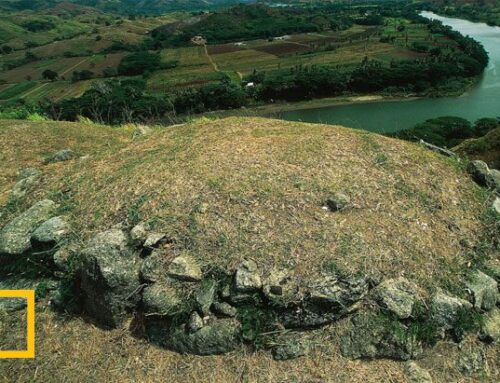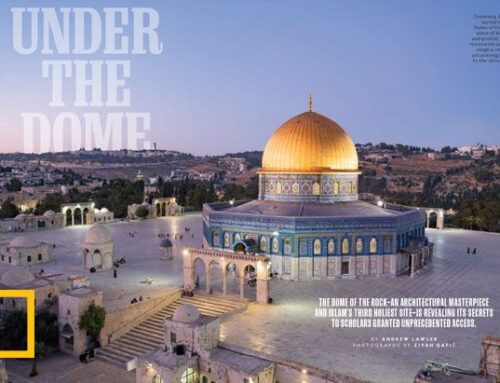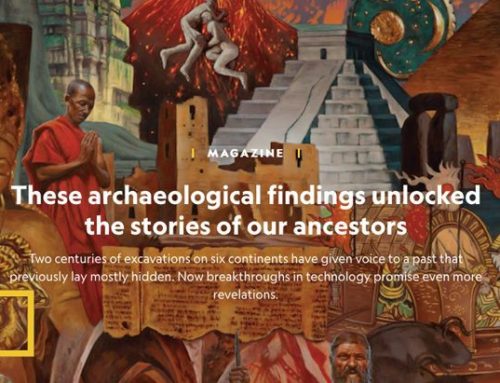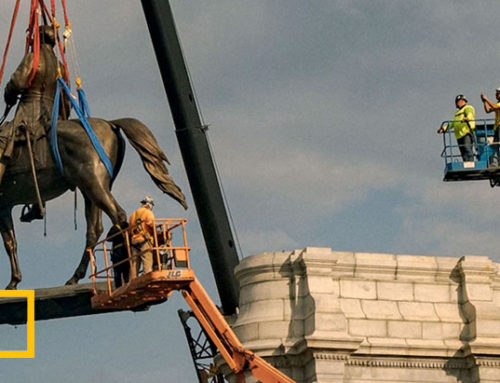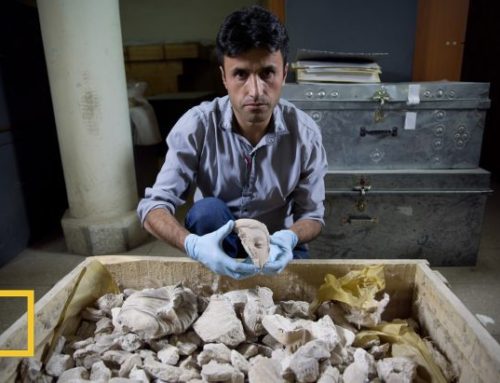Amid conflict with ISIS and a budget crisis, Iraqi officials hope new museum will herald a revival of the ancient port city of Basra.

Saddam’s former palace in Basra boasts a heart-shaped lake and extensive grounds. Officials are now turning it into a museum. Photograph by Essam Al-Sundai, AFP, Getty Images
BASRA, Iraq—Mahdi al-Musawi has a problem. His construction company is rushing to complete work on Iraq’s newest and most ambitious museum, which is slated to open by September. But above the main door, carved in sweeping Arabic calligraphy in beautiful wood, is the name of former Iraqi ruler Saddam Hussein and the soubriquet “Prince of Arabs.”
“Politicians will be here for the dedication,” al-Musawi says, eyeing the elaborate script. “They won’t be happy with this.”
Iraqi officials, however, are confident that converting one of Saddam’s former palaces into a museum—the first museum to open in the country in decades—will help spark a cultural revival in Basra, a southern port city and the country’s second largest and fastest growing urban center.
From Saddam to Sumerians
Given that ISIS forces have devastated much of the heritage in Iraq’s north, opening a new museum might seem a quixotic venture. While the forces of the Islamic State are far from Basra, reminders of the conflict are close at hand.
A Shiite militia group based in trailers just down the street occasionally threatens to requisition the palace, al-Musawi says. And the elaborate structure still bears the scars of several car bombs from when it served as a British Army mess hall after the 2003 invasion.
But in recent years, political stability, an influx of people from the beleaguered north, and a growing oil business just beyond the city limits have turned Basra into a boomtown, making it a prime location for a new cultural attraction.
“When the British left in 2008, I suggested that the central government turn the palace over to us,” says Qahtan al-Abeed, director of the Basra section of Iraq’s State Board of Antiquities and Heritage.
Winning central government approval took two years. The Basra government then agreed to fund $3 million of the $3.5 million project. A United Kingdom charity called the Friends of Basrah Museum collected donations to cover the difference, mostly from oil companies, and the British Museum is providing free curatorial support.

Basra, Iraq, seen here in 1925, is now the country’s fastest growing urban center.
Photograph by The Print Collector, Print Collector, Getty Images
A Collection Behind Steel Doors
When complete, the museum will include four halls that display artifacts from ancient Sumer, Babylon, Assyria, and Islamic periods of Iraq’s long history. “The whole museum will have 3,500 to 4,000 objects” drawn from the vast storage rooms of Baghdad’s Iraq Museum and displayed in more than one hundred cases, al-Abeed says.
Mindful of the 2003 looting of the Iraq Museum, al-Abeed ordered thick steel doors installed at the entrance to each gallery that can be quickly sealed. But he says security must be balanced by openness. “We want a very modern museum that does more than display objects,” he says. “We want to bring in people for all kinds of art and cultural activities, including training courses and professional meetings.”
None of this can happen just yet, as the Basra government hasn’t put up its share of the renovation costs.
“Like anything else in Iraq, it is difficult to achieve the simplest task,” says Lamia Al-Gailani Werr, a trustee of the Friends of Basrah and an Iraqi who lives in London. The committee suggested that al-Abeed open one gallery as soon as possible, to encourage the government to support the effort. He hopes to do so by September.
Werr praises al-Abeed for his tenacity in pushing forward the museum. But his ambitious vision for Basra, where he was born but fled during the time of Saddam Hussein, extends beyond the renovated palace.

Picture of palace of Iraq’s executed former president Saddam Hussein in the southern city of Basra
Financial strain has delayed the opening of the palace-turned-museum, but officials are hopeful it will see its first visitors in the fall.
Photograph by Essam Al-Sudani, AFP, Getty Images
One of the World’s Largest Archaeological Sites
Basra has a rich and varied history that al-Abeed wants to bring to the world’s attention, and not only through a museum. Famed as the home of the legendary Sinbad, the city was founded in A.D. 636 and became an important and wealthy port central to Indian Ocean trade as well as an intellectual and artistic center.
The original city site, called Zubair, now lies just outside modern Basra. The massive archaeological site covers more than 1,200 acres (486 hectares) and is one of the largest and least explored in the world. The area remained mostly uninhabited until the 1990s, when Saddam turned over some of the land for construction of factories.
“I sued and the courts asked 17 factories to leave,” al-Abeed says. Twenty factories remain in the otherwise barren area. He says he has received death threats for his actions, forcing him to move out of his family home and into a more secure compound.
With Basra expanding and land prices skyrocketing, al-Abeed’s organization is under intense pressure to prove that significant archaeological remains cover the site, so that it won’t be further developed and the history can be protected.
“We have obvious structures everywhere, including walls and small domes,” said Ali Almayahi, a geophysicist at the University of Basra who is leading an effort to map the site using ground-penetrating radar. In one trench, al-Abeed said his team found pottery, glass, and other material dating to Abbassid times, from the eighth to the 13th centuries A.D. But he is in a race against time as new highways spring up around and through the site.

Saddam’s elaborate former palace in Basra will soon be Iraq’s first new museum in decades. Photograph by Mahan Kalpa Khalsa
Rescuing Old Basra
In late medieval times, the city shifted north in order to follow the changing course of the Tigris and Euphrates Rivers. At the heart of modern bustling Basra, north of the museum site, lies a quiet neighborhood with hundreds of century-old mansions with intricate wooden grillwork along stone-lined canals with graceful arched bridges, interspersed with old churches and mosques.
Today the canals are dry and choked with trash, the bridges crumbling, and the once elegant homes are rapidly disintegrating. But a few structures have been rehabilitated and are home to a growing number of arts organizations. On a recent morning, artists at a cooperative were preparing an exhibition of modernist sculpture. It’s a remarkable sight in a city that just a few years ago saw frequent clashes of competing militias.

The interior of the palace boasts massive chandeliers and intricate tile work on a massive central dome. Photograph by Mahan Kalpa Khalsa
Down the street is the Basra Cultural Palace, based in a large 19th-century home built by a Jewish merchant. “We just had a painting exhibit from Kuwait, and a writing conference for women,” said the director, Hussain al-Mothater.
Al-Abeed sees the rehabilitation of the old quarter as his most challenging and long-term task. “The buildings are in bad condition, and people are pulling them down,” he says.
“We want to make this a heritage area with hotels and restaurants and a heritage museum, but being sure that people still live here,” he added. “We want to make this like Granada in Spain, but this is a 15- to 20-year project.” He is taking steps to list the area as a World Heritage site under UNESCO.
That vision might seem as fantastic as one of Sinbad’s tales, but al-Abeed is relentlessly optimistic. “Most people from Basra came here recently from the countryside, and they have no idea of culture. You have to first lay the foundation. And I want to help my country.”
